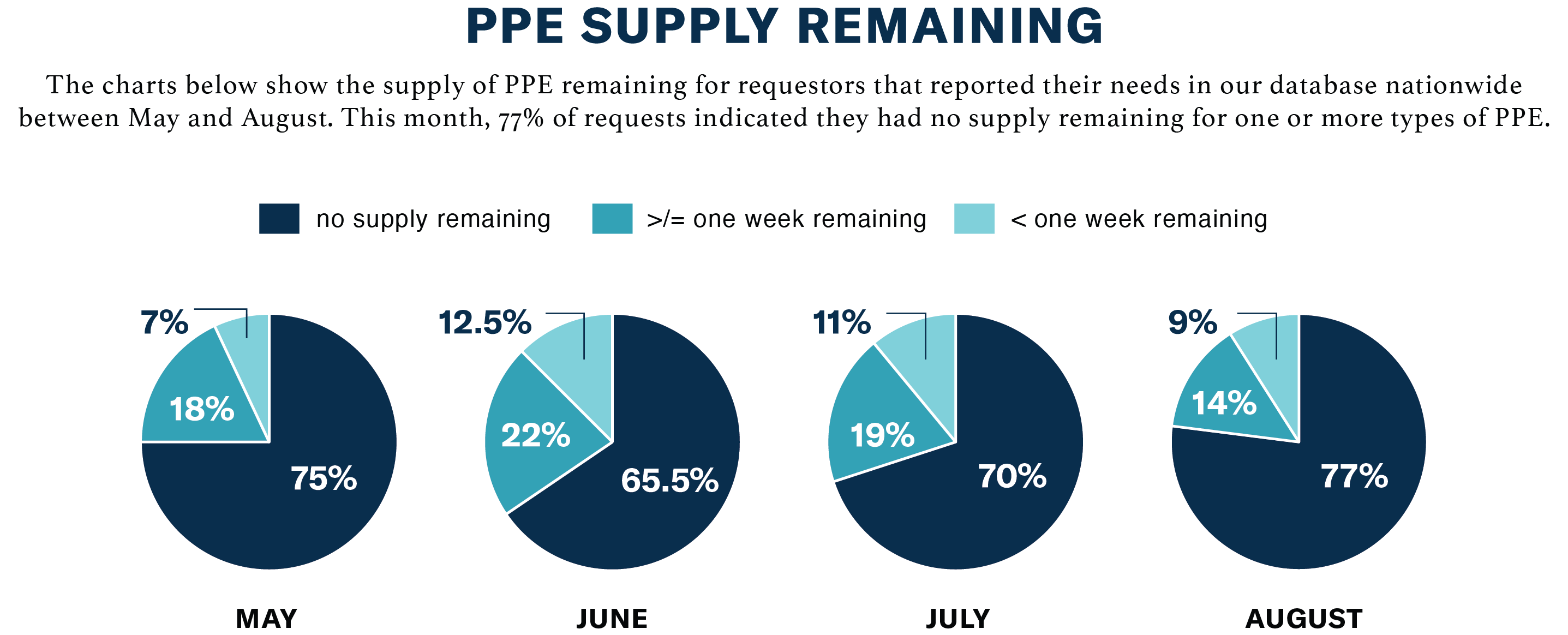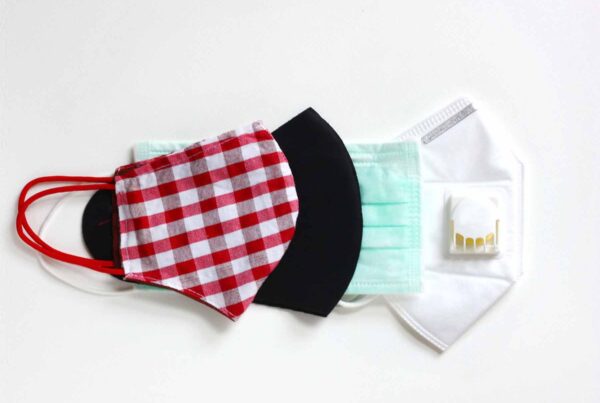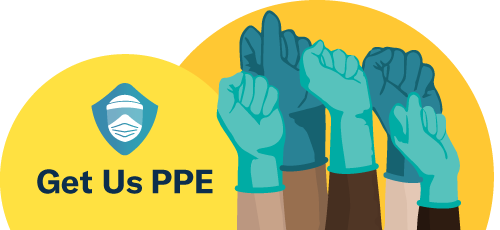Monthly Report of PPE Shortage Data Shows 77% of Facilities Have No Supply Remaining
of One or More Types of PPE

WASHINGTON, D.C. – September 2, 2020. Get Us PPE, the nation’s largest nonprofit delivering personal protective equipment (PPE) to frontline facilities in need, today announced the launch of the PPE Shortage Index, a detailed monthly report on the ongoing PPE crisis in the United States. The Index shows that thousands of healthcare facilities and other frontline organizations are still facing alarming shortages of personal protective equipment. In August, 77% of facilities in the Get Us PPE database had no supply remaining of at least one type of PPE.
The PPE Shortage Index offers the most comprehensive view of the PPE crisis to date. Get Us PPE has received over 16,000 requests for PPE, with over 21 million units requested altogether. From these requests, they have built the largest non-governmental database of PPE needs in the country. Only a small percentage of frontline facilities have registered with the organization, so shortages are likely even more severe than their data shows.
Get Us PPE has received requests for personal protective equipment from all 50 states and some U.S. territories. Although they have delivered over 2.3 million pieces of PPE, they have only been able to fulfill 10% of the PPE needs registered in their database. Their most recent data paints a bleak picture of the PPE shortage today, five months after COVID-19 began to spread widely in the United States.
The PPE Shortage Index shows that, in August, there was a strong correlation between a state’s number of PPE requests and new COVID-19 cases reported in that state. Also in August, in addition to the 77% of facilities reporting that they were completely out of at least one type of PPE, 9% had less than a week’s supply remaining of at least one type of PPE, and only 14% had more than a week’s worth of all essential PPE.
The PPE crisis began in the early days of the COVID-19 pandemic when the PPE supply chain could not keep up with the dramatic increase in demand. In late March, healthcare workers – including the emergency physicians who co-founded Get Us PPE – began to speak out about the PPE shortages they were experiencing. Now, more than five months later, the supply chain is catching up, but many facilities still lack the personal protective equipment they need in order to protect frontline workers and prevent the spread of COVID-19.
“The PPE shortage problem was never really solved,” says Dr. Megan Ranney, emergency physician and co-founder of Get Us PPE. “Over the past couple months, many large hospitals have been able to stock up on the PPE they need, but small and under-resourced facilities are still struggling to find affordable PPE. If you live in a rural community, or a Black or indigenous community, your local facilities are less likely to have enough PPE. The PPE crisis has become a health equity issue.”
The PPE Shortage Index shows an increasing percentage of PPE requests from non-hospital organizations including nursing homes, shelters, social services providers, and home health agencies. These types of organizations often serve populations especially vulnerable to COVID-19 infection.
 Get Us PPE is preparing for even more dire PPE shortages in the coming months as COVID-19 infection rates are expected to rise in the fall and winter. “Get Us PPE has mobilized its grassroots volunteer network to deliver over two million pieces of PPE across the country, but there are so many others desperately in need of PPE, and time is of the essence,” says Dr. Shikha Gupta, the Director of Development and Communications at Get Us PPE. “We hear from doctors and nurses at rural health clinics who are using raincoats instead of hospital gowns, and from nursing homes caring for COVID-positive patients without any PPE at all. Our PPE Shortage Index shows how widespread the PPE crisis still is.”
Get Us PPE is preparing for even more dire PPE shortages in the coming months as COVID-19 infection rates are expected to rise in the fall and winter. “Get Us PPE has mobilized its grassroots volunteer network to deliver over two million pieces of PPE across the country, but there are so many others desperately in need of PPE, and time is of the essence,” says Dr. Shikha Gupta, the Director of Development and Communications at Get Us PPE. “We hear from doctors and nurses at rural health clinics who are using raincoats instead of hospital gowns, and from nursing homes caring for COVID-positive patients without any PPE at all. Our PPE Shortage Index shows how widespread the PPE crisis still is.”
Dr. Ranney explains that the PPE shortage has lasted much longer than anticipated. “We were expecting Get Us PPE to only need to exist for about two weeks, but we’ve been around for five months and the PPE crisis isn’t going anywhere,” she says. “If we as a country put more resources into PPE manufacturing and equitable distribution, we can begin to solve this problem.”
Get Us PPE will be releasing the PPE Shortage Index on a monthly basis to track the evolving national PPE crisis.
Components of the PPE Shortage Index
- About Get Us PPE
- Demand, Donations, Distributions
- Total PPE Requests
- Change in Requests, Select States
- Top 3 Most Requested Items Nationally This Month
- Supply Remaining Nationally
- Supply Remaining by PPE Type
- % Requests from Hospitals vs. Non-Hospitals
- Top PPE Items Requested Nationally by Month
- Most Requested PPE Item per Month
- Requests x COVID-19 Caseload
- Regional Data
- About the Data
About Personal Protective Equipment (PPE)
Personal Protective Equipment (PPE) includes items such as respirators (N95s and equivalent), face shields, gowns, booties, and gloves that protect healthcare and other frontline workers from viral particles on surfaces and during other situations of close patient contact. It can also refer to cloth masks and other non-medical grade protective equipment worn by the general population.
About Get Us PPE
Get Us PPE is an organization founded by emergency physicians at the beginning of the COVID-19 pandemic. It began as a grassroots effort to connect PPE donations with healthcare workers in need. Today, it has become the leading national nonprofit delivering protective equipment, free of charge, to frontline workers and underserved communities. Along with building the largest non-governmental database of PPE needs in the country, Get Us PPE has developed an equitable distribution algorithm, the Fairness Framework, to objectively determine where PPE is needed most.
Media Contacts
Amanda Peery-Wolf, PR Manager
Stephanie Zeller, PR & Data Visualization Strategist
Phone: +1 (631) 853-9164
Email: media@GetUsPPE.org




